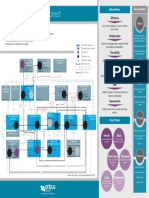0 ratings0% found this document useful (0 votes)
9 viewsConsistency Models in Distributed Systems
Uploaded by
mwanahawabaguoCopyright
© © All Rights Reserved
Available Formats
Download as PDF, TXT or read online on Scribd
0 ratings0% found this document useful (0 votes)
9 viewsConsistency Models in Distributed Systems
Uploaded by
mwanahawabaguoCopyright
© © All Rights Reserved
Available Formats
Download as PDF, TXT or read online on Scribd
You are on page 1/ 1
Ensure data correctness across multiple
nodes in distributed systems
Key Purpose
Balance between consistency, availability,
and performance (CAP theorem).
A Consistency Model is a formal contract
between a distributed system's data store and
the processes accessing it. Balancing consistency, availability, and
partition tolerance (CAP theorem).
Once a process reads a value, it will
Introduction to Consistency Models
Key Challenges
never see an older value.
Synchronizing updates across geographically
Email systems ensuring older emails Specifies how updates to replicas are seen across the system. distributed replicas.
Example Monotonic Reads Focused on individual clients maintaining
remain visible after syncs. Defines acceptable behavior for reads and writes.
a consistent view of the data.
Ensures writes by a single
process are applied in order. (e.g., Amazon DynamoDB, Google
Client-Centric Consistency Models Cloud databases
Distributed version Spanner).
Exampl Monotonic Writes
control systems like Git
Guarantees that a process sees Use Cases Distributed file systems (e.g., NFS, HDFS).
its own updates in subsequent
reads.
Blogs immediately reflecting DNS systems, caching mechanisms, and collaborative tools
Example Read-Your-Writes
the author’s changes
Ensures that writes following a
read are applied to the most Provides a strong
recent value Advantages guarantee of correctness.
E-commerce platforms ensuring All reads return the result of the
Example Writes-Follow-Reads most recent write, regardless of Impractical in large-scale distributed systems due to
cart updates are consistent
where the write occurred. synchronization overhead.
Strict Consistency Disadvantages Requires global clocks or perfectly synchronized systems.
Example Stock trading systems enforcing
Long-lived, stable replicas strict transaction ordering.
Permanent Replicas
in server clusters. All processes see operations in the Easier to implement than
same order, but this order need not Advantages strict consistency
Focused on maintaining a global view of Allows some level of asynchrony
align with real-time.
Created for performance the data store across replicas.
improvement (e.g., CDN replicas). Server-Initiated Replicas Replica Types May lead to performance
Sequential Consistency Disadvantages
Data-Centric Consistency Models bottlenecks if writes are prioritized
Created temporarily based on client Example Shared memory systems ensuring
Replica Placement and Synchronization program order for threads.
requests (e.g., browser caches). Client-Initiated Replicas (Models without Synchronization)
Consistency Models in Distributed Systems These models define how the entire
Notify replicas when data is outdated. Invalidation Protocols system behaves globally and ensure Extends sequential consistency by ensuring
consistency of shared data Advantages Guarantees correct operation ordering
real-time ordering of operations.
Updates applied to all Synchronization Mechanisms
Active Replication High performance cost due to
replicas simultaneously. Linearizability (Atomic Consistency) Disadvantages
real-time constraints
Updates sent automatically by the server. Push Example: Banking systems ensuring debits
Push/Pull Protocols occur before withdrawals.
Clients request updates when needed. Pull
Guarantees that causally related
operations are seen in the same
order by all processes. Operations not causally related may be
Concurrent Operations observed in different orders.
Causal Consistency
Social media: Comments must appear
Example
after the post they reference.
Writes from a single process are
observed in order, but writes from
Suitable for large-scale systems where Ensures all replicas eventually different processes may be seen in
Advantages converge to the same state. varying orders.
immediate consistency isn’t critical. Advantages Lightweight implementation.
FIFO Consistency
Eventual Consistency (PRAM Consistency)
Temporary inconsistencies can occur Disadvantages Example Logs from distributed processes.
Uses synchronization variables
DNS resolving domain names. Example Ensures consistency only after explicit Mechanism to enforce consistency.
synchronization operations.
Weak Consistency
Focused on relaxing consistency Example Parallel programming environments with
Efficiently spread updates to all guarantees to improve shared memory
replicas using minimal messages. performance and scalability.
Acquire Ensures updates are visible
Example Epidemic Protocols before accessing data
Weak Consistency Models Uses acquire and release Definition
operations for synchronization.
Release Propagates changes upon
Randomly synchronize exiting a critical region.
(Models with Synchronization) Release Consistency
updates between replicas. Advantages Provides better performance by separating
synchronization from data access.
Anti-Entropy Protocols Advanced Protocols
Example Distributed file systems using
locks for access control.
Incrementally spread
updates among replicas. Synchronization applies at the
level of specific data items, not Advantages Efficient for localized critical sections.
Gossip Protocols
the entire data store.
Entry Consistency
Collaborative tools like Google Docs
Example
managing document sections
You might also like
- Contract: Course Objectives National StandardsNo ratings yetContract: Course Objectives National Standards2 pages
- Reza Negarestani - Complexity-ComputationNo ratings yetReza Negarestani - Complexity-Computation1 page
- Fully Convolutional Networks For Semantic Segmentation: Jonathan Long Evan Shelhamer Trevor Darrell UC BerkeleyNo ratings yetFully Convolutional Networks For Semantic Segmentation: Jonathan Long Evan Shelhamer Trevor Darrell UC Berkeley10 pages
- 19 Is 000003 BRO Symmetry Cracking Furnace Feb 2020No ratings yet19 Is 000003 BRO Symmetry Cracking Furnace Feb 20205 pages
- The Language of Trustworthy AI_ An In-Depth Glossary of Terms (updated August 4, 2024)No ratings yetThe Language of Trustworthy AI_ An In-Depth Glossary of Terms (updated August 4, 2024)22 pages
- WWW WWW WWWWWW WWWWWW WWW WW WWWWW: Informative and Elegant With SurvminerNo ratings yetWWW WWW WWWWWW WWWWWW WWW WW WWWWW: Informative and Elegant With Survminer1 page
- Derivation of An Error Bound For Model Reduction of Second Order SystemsNo ratings yetDerivation of An Error Bound For Model Reduction of Second Order Systems4 pages
- An Introduction To Optimal Control Applied To Disease ModelsNo ratings yetAn Introduction To Optimal Control Applied To Disease Models37 pages
- An GIlossary of Terms (AI_RMF_Knowledge_Base_Glossary)No ratings yetAn GIlossary of Terms (AI_RMF_Knowledge_Base_Glossary)23 pages
- Li Your Diffusion Model is Secretly a Zero-Shot Classifier ICCV 2023 PaperNo ratings yetLi Your Diffusion Model is Secretly a Zero-Shot Classifier ICCV 2023 Paper12 pages
- 04 Syllabus - Aircraft Structural DynamicsNo ratings yet04 Syllabus - Aircraft Structural Dynamics9 pages
- EnerMaps D1.4 DatasetList January2021 WEBNo ratings yetEnerMaps D1.4 DatasetList January2021 WEB4 pages
- Recursive Routing Networks: Learning To Compose Modules For Language UnderstandingNo ratings yetRecursive Routing Networks: Learning To Compose Modules For Language Understanding18 pages
- Tier_1_Critical_Documentation_Dependancy_MatrixNo ratings yetTier_1_Critical_Documentation_Dependancy_Matrix6 pages
- BPMN 2.0 - Business Process Model and Notation Innovator For Business AnalystsNo ratings yetBPMN 2.0 - Business Process Model and Notation Innovator For Business Analysts1 page
- Poster - Monitoring Protein Degradation in Living Cells - PromegaNo ratings yetPoster - Monitoring Protein Degradation in Living Cells - Promega1 page
- Top Achievement Chart 2021 For ReportingNo ratings yetTop Achievement Chart 2021 For Reporting9 pages
- Huawei Technology Campus Network Solution BrochureNo ratings yetHuawei Technology Campus Network Solution Brochure16 pages
- Mooring Cost Sensitivity Study Based On Cost-Optimum Mooring DesignNo ratings yetMooring Cost Sensitivity Study Based On Cost-Optimum Mooring Design6 pages
- Dynamic Phasors in Modeling and AnalysisNo ratings yetDynamic Phasors in Modeling and Analysis42 pages
- Lessons From Capital Market History, Part 1: ViewpointNo ratings yetLessons From Capital Market History, Part 1: Viewpoint2 pages
- Event Setup - E-Mail Report Studio Report To UsersNo ratings yetEvent Setup - E-Mail Report Studio Report To Users5 pages
- Bureau Brandeis - GDPR Compliance RoadmapNo ratings yetBureau Brandeis - GDPR Compliance Roadmap33 pages
- Handling Email Confirmation During Registration in Flask: by Real Python 45 CommentsNo ratings yetHandling Email Confirmation During Registration in Flask: by Real Python 45 Comments15 pages
- Robot Operating System 2: Design, Architecture, and Uses in The WildNo ratings yetRobot Operating System 2: Design, Architecture, and Uses in The Wild13 pages
- Web Application Cinema Enhanced by ClassificationNo ratings yetWeb Application Cinema Enhanced by Classification45 pages
- 16.4.6-Packet-Tracer - Configure-Secure-Passwords-And-SshNo ratings yet16.4.6-Packet-Tracer - Configure-Secure-Passwords-And-Ssh4 pages
- Oracle SOA Suite 12.2.1.4.0 InstallationNo ratings yetOracle SOA Suite 12.2.1.4.0 Installation64 pages
- Web Application Scanning Detailed Scan Export: Pontual Scan: April 3, 2023 at 14:00 (UTC)No ratings yetWeb Application Scanning Detailed Scan Export: Pontual Scan: April 3, 2023 at 14:00 (UTC)71 pages
- Vinod Sharma: Enterprise-Level Salesforce Project Management/Business Analysis ExperienceNo ratings yetVinod Sharma: Enterprise-Level Salesforce Project Management/Business Analysis Experience3 pages
- SETLabs Briefings Performance EngineeringNo ratings yetSETLabs Briefings Performance Engineering84 pages
- MCQ From Control Statement To Pointer-2019No ratings yetMCQ From Control Statement To Pointer-20192 pages
- CS2255 DATABASE MANAGEMENT SYSTEMS (2marks and 16 Marks) Unit-I Part-ANo ratings yetCS2255 DATABASE MANAGEMENT SYSTEMS (2marks and 16 Marks) Unit-I Part-A32 pages

























































































